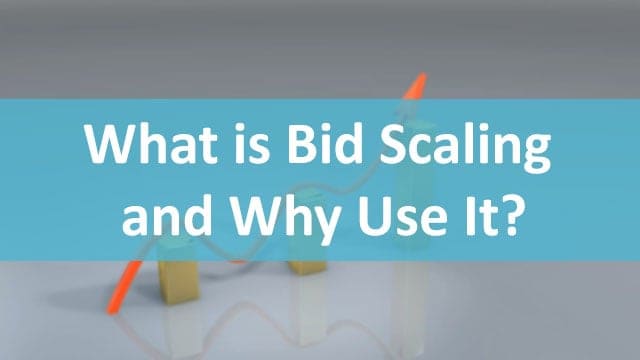
This post was most recently updated on September 14th, 2021
Bid scaling is used to make all bids compete in the auction as an apples-to-apples comparison based on the net amount paid to the publisher. Bid scaling occurs between receiving the bids and passing the bids up into DFP. All bid scaling principles are applied to all demand fairly, equally, and non-discriminately based on that individual bidder’s revenue.
We typically notify bidders if there’s a significant negative change in their scaling. There are many reasons to scale bids:
Every bidder typically has a discrepancy between what DFP reports for that bidder and what the bidder reports themselves. This applies to non-HB demand also at the dynamic allocation level in DFP’s “value CPM” field. Some direct sold campaigns and a minority of bidders agree to pay based on DFP trafficked numbers, but the bulk of bidders only bill off their own metrics.
Not all demand is created equal — some bidders have terrible discrepancies compared to others, even when bidding from exchanges that allow aliased bidders. For example, AppNexus has multiple bidders using its platform, but each has its own discrepancy that varies widely. When a bidder’s reporting interface is consistently off from DFP’s reporting over significant impression volumes, we scale the bids from that bidder down accordingly. This incentivizes bidders to keep their discrepancies low and keeps the auction as an apples-to-apples comparison across all bidders.
For example, if we have Bidder98 who consistently pay 98 cents on the dollar based on DFP reporting and Bidder70 who consistently pays only 70 cents on the dollar, it’s unfair in the auction to compare them directly. An $8 bid from Bidder98 is worth more to the publisher than a $10 bid from Bidder70. In this case, Bidder98 is automatically scaled down 2% and Bidder70 is automatically scaled down 30%. Bidder98’s $8 bid will go into the auction at $7.84 and Bidder70’s bid will go into the auction at $7.00.
We are currently in the process of drilling down discrepancies at a much more granular level — some bidders have higher discrepancies on certain units, device types, or geos, so a blanket discrepancy scale improperly over scales some of their bids while not scaling other bids enough. We regularly work with our demand partners to minimize discrepancy based scaling.
Most bidders bid in USD, but some do not. Additionally, not all pubs have their DFP accounts in USD. If the currency is not adjusted to match the DFP currency before it goes into DFP, the line items will be expecting bid values in the DFP currency, but the bid value is usually in USD. This causes serious econometric failures in the auction when comparing header bidding bids vs non-header bidding line items (especially AdSense/AdX).
We update currency conversion regularly from major FX data sources. We do not charge or any currency exchange fee as that is typically between the publisher and their financial institution if there is one. Some foreign pubs will even have their banking done in USD while their DFP account is in their local currency.
Additionally, there’s an issue where currency conversion overlaps with discrepancies. When foreign currency pubs are dealing with bidders of other currencies, some bidders run the conversion immediately. Others make the conversion at the time of payment, so there’s no other way to shore up an account at the end of the payment period other than using some discrepancy scaling. There’s no way to guarantee at the time of the impression what the conversion will be paid out at because currencies fluctuate. At the time of the impression, the pub has taken on the currency fluctuation risk, and then the pub uses the discrepancy modifier to shore up the numbers. This often has a couple of percentage points spread in a month either direction, but occasionally it can be much larger (e.g. when Brexit hit in 2016).
When a bid comes into the publisher, sometimes the bidder hasn’t taken out their own cut of the rev-share. This is called a gross bid. If the bidder takes out their rev-share, the bid is a net bid. Some bidding platforms do not support net bids (at least 30% of all major bidders send gross bids). The bid must be scaled down before it enters the auction to make sure the bidder’s revenue share has been removed. Prebid added real-time bid scaling as a default feature in 2015 Q4 specifically for this issue: https://github.com/prebid/Prebid.js/issues/17
You can also read our related article about Prebid Header Bidding.
Also known as the time value of money, a $10 bid at net 90 is worthless to a publisher than a $9.80 bid at net 30. We have a standardized NPV chart that scales down bids based on payment terms, usually only a couple percentage points. Slower paying bidders are scaled down more than faster-paying bidders. This percentage is backed out in discrepancy calculations so it’s not counted twice.
One bidder even charges a couple of percentage points for net 30 vs net 90; that fee is passed back up onto the bidder via bid scaling.
Some bidders in the past only paid for viewable impressions. Over millions of impressions, the expected value of the payout on that impression is able to be used for the bid. For example, if the unit is 70% viewable, and the bidder sends a $10 bid, that bid would go into the auction as its statistical expected value, or $7. No bidders currently use this technique, but our tech still supports it.
For most MonetizeMore publishers, we manage most or all of their ad stack, so all demand sources are equally affected by our tech fees and no tech fee scaling applies.
For a small minority of publishers, they have substantial direct sales and we only run their header bidding. In these cases, the pub will usually include overhead in their line items, and to make their auction apples-to-apples, we must scale down header bidding bids by our revenue share.
Some large publishers are running DFP Premium and are charged a small fixed CPM fee on impressions trafficked by DFP which aren’t Google’s Adsense/Adx demand. For publishers being charged for DFP Premium at this CPM level, we can apply a fixed CPM scale. For example, if a bidder sends a $0.02 bid for an impression, and Google charges the publisher $0.04 CPM for non-Google impressions, the publisher actually loses money running that impression. Net bids under 1 penny are ignored, so this bid would not be considered eligible for the impression.
Are you ready to partner with a Google Certified Publisher Partner and take your ad revenue to the next level? Sign up for a Premium account at MonetizeMore today!

Kean Graham is the CEO and founder of MonetizeMore & a pioneer in the Adtech Industry. He is the resident expert in Ad Optimization, covering areas like Adsense Optimization,GAM Management, and third-party ad network partnerships. Kean believes in the supremacy of direct publisher deals and holistic optimization as keys to effective and consistent ad revenue increases.

Paid to Publishers
Ad Requests Monthly
Happy Publishers
10X your ad revenue with our award-winning solutions.